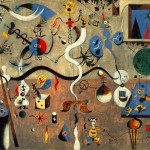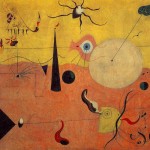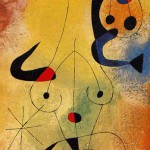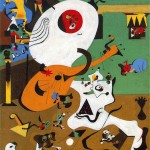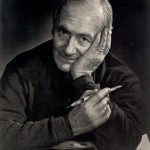Joan Miro
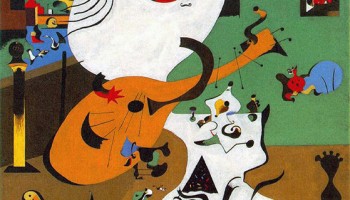
Joan Miro was born on April 20, 1893 in Barcelona, Catalonia, Spain. He was the son of a goldsmith and a jewellery maker. His work is often referred to as whimsical and childlike and is primarily associated with the Surrealist art movement.
In his youth, Miro was enticed by the art movements that were happening in France at the time and in 1920 he moved to Paris. There, under the influence of Surrealist poets and writers, he refined his own singular approach to art: organic forms and two-dimensional planes painted with highly contrasted lines. He was primarily considered to be a Surrealist because of his attraction to automatism and his application of sexual symbols. Miro’s style was greatly influenced by both Surrealism and Dada, yet he refused to be attached to any artistic movement of the time.
Click here to continue reading
Andre Breton, the fore-bearer of Surrealism, characterized him as “the most Surrealist of us all.” Breton was known for his affinity to automatism and advocated the use of sleep deprivation, starvation, and taking drugs for affecting hallucinogenic states used to create art that brings forth the subconscious. Miro once admitted to painting one of his most well known works, Harlequin’s Carnival, under those conditions.
In 1926, Miro worked with the artist Max Ernst on set designs for Sergei Diaghilev’s ballet company. On Oct. 12, 1929 Miro wed Pilar Juncosa, and on July 17, 1931; their daughter Dolores was born. Shuzo Takiguchi published the first monograph on Miro in 1940. In 1959, Miro was asked by Andre Breton to represent Spain in The Homage to Surrealism exhibition along with artwork by notable surrealists Salvador Dali, Eugenio Granell and Enrique Tabara.
By not officially aligning himself with the Surrealist movement, Miro was freely able to explore any artistic style he wanted to without exasperating his standing within the group or being ridiculed for not being a pure Surrealist. He made sure that he was free to follow his own interests in the art world. The fact that he did not conform to any one specific style, is evident in his art and his readiness to work with a variety of medium.
Miro never liked art critics. He was quoted during an interview “They are more concerned with being philosophers than anything else. They form a preconceived opinion, then they look at the work of art. Painting merely serves as a cloak in which to wrap their emaciated philosophical systems”.
In the latter part of his career, Miro increasingly began expanding his medium, particularly with ceramics, glass and tapestry. He produced hundreds of ceramics during this period including one of his more famous pieces “Wall of the Moon and Wall of the Sun” displayed at the United Nations Educational, Scientific and Cultural Organization building in Paris.
In 1974, Miro was commissioned to create a tapestry for the World Trade Center in New York City where it was displayed for many years until it was lost during the attack of the twin towers on September 11th 2001.
Miro died December 25, 1983 at his home in Palma, Mallorca due to heart disease. He was 90 when he passed. He will be remembered through his art which is displayed in Major Art museums and art collections all over the world.
- Carnival of Harlequin – 1924-25
- Catalan Landscape (The Hunter) – 1923-24
- Dawn Perfumed by a Shower of Gold – 1954
- Dutch Interior I – 1928
- Photograph of Joan Miro
- Portrait IV – 1938
- Rhythmic Personages – 1934
- The Two Philosophers – 1936

